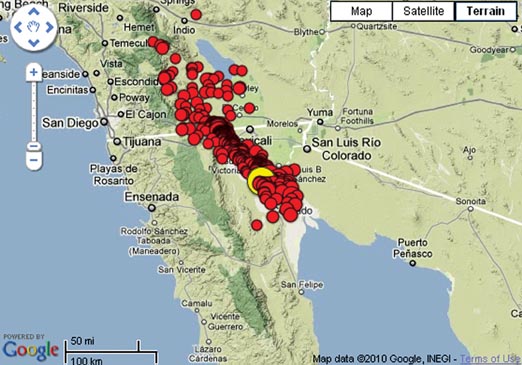MALIBU/LOS ANGELES—An earthquake that occurred in Mexico on Easter Sunday created aftershocks that were felt in different parts of Southern California.
The 7.2 quake that hit Baja sent aftershocks from Downtown Los Angeles to San Diego.
The U.S. Geology Survey said on their Web site (earthquake.usgs.gov) that a 3.0 quake struck Malibu at 4:10 p.m.
According to Erik Scott from the Los Angeles Fire Department, there were no significant damages or injuries.
“LAFD had a slight increase in 911 calls, mostly associated with automatic alarms and stuck elevators. But no significant damage or injuries were reported,” said Scott.
Many people, including celebrities, took the networking route, and wrote public messages after feeling the earthquake. On Twitter, Paris Hilton wrote, “So scary, just felt an Earth Quake! Anyone else feel it? I hope there isn’t anymore.”
The USGS offers on their Web site, “Seven Steps to Earthquake Safety”:
Step 1: Secure it now!
Reducing and/or eliminating hazards throughout your home, neighborhood, workplace and school can greatly reduce your risk of injury or death following the next earthquake or other disaster. Conduct a “hazard hunt” to help identify and fix things such as unsecured televisions, computers, bookcases, furniture, unstrapped water heaters, etc. Securing these items now will help to protect you tomorrow.
Step 2: Make a plan
Planning for an earthquake, terrorist attack, or other emergency is not much different from planning for a party or vacation. Make sure that your emergency plan includes evacuation and reunion plans, your out-of-state contact person’s name and number, the location of your emergency supplies and other pertinent information. By planning now, you will be ready for the next emergency.
Step 3: Make disaster kits
Everyone should have disaster supplies kits stored in accessible locations at home, at work and in your vehicle. Having emergency supplies readily available can reduce the impact of an earthquake, a terrorist incident or other emergency on you and your family. Your disaster supply kits should include food, water, flashlights, portable radios, batteries, a first aid kit, cash, extra medications, a whistle, fire extinguisher, etc.
Step 4: Is your place safe?
Most houses are not as safe as they could be. Whether you are a homeowner or a renter, there are things that you can do to improve the structural integrity of your home. Some of the things that you might consider checking include inadequate foundations, unbraced cripple walls, soft first stories, unreinforced masonry and vulnerable pipes. Consult a contractor or engineer to help you identify your building’s weaknesses and begin to fix them now.
Step 5: DROP, COVER and HOLD ON!
Learn what to do during an earthquake, whether you’re at home, at work, at school or just out and about. Taking the proper actions, such as “Drop, Cover, and Hold On,” can save lives and reduce your risk of death or injury. During earthquakes, drop to the floor, take cover under a sturdy desk or table, and hold on to it firmly. Be prepared to move with it until the shaking stops.
Step 6: Check it out!
One of the first things you should do following a major disaster is to check for injuries and damages that need immediate attention. Make sure you are trained in first aid and in damage assessment techniques. You should be able to administer first aid and to identify hazards such as damaged gas, water, sewage and electrical lines. Be prepared to report damage to city or county government.
Step 7: Communicate and recover!
Following a major disaster, communication will be an important step in your recovery efforts. Turn on your portable radio for information and safety advisories. If your home is damaged, contact your insurance agent right away to begin your claims process. For most Presidentially declared disasters, resources will also be available from federal, state and local government agencies.






